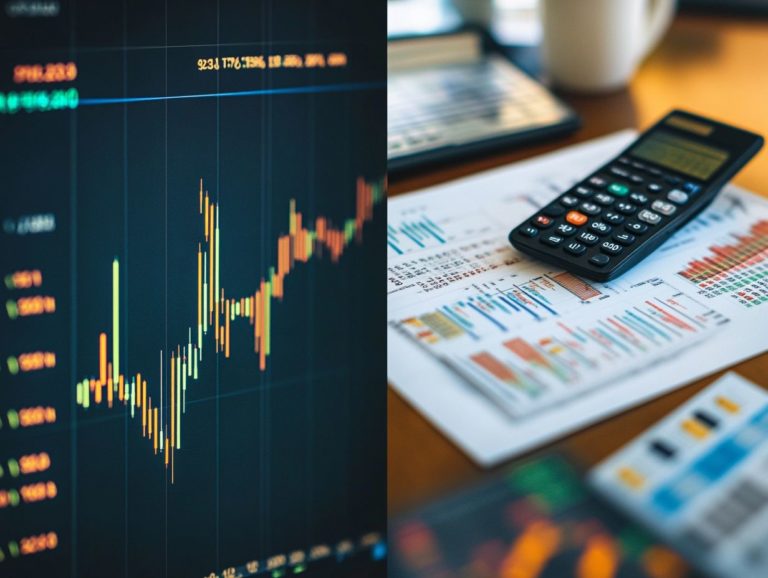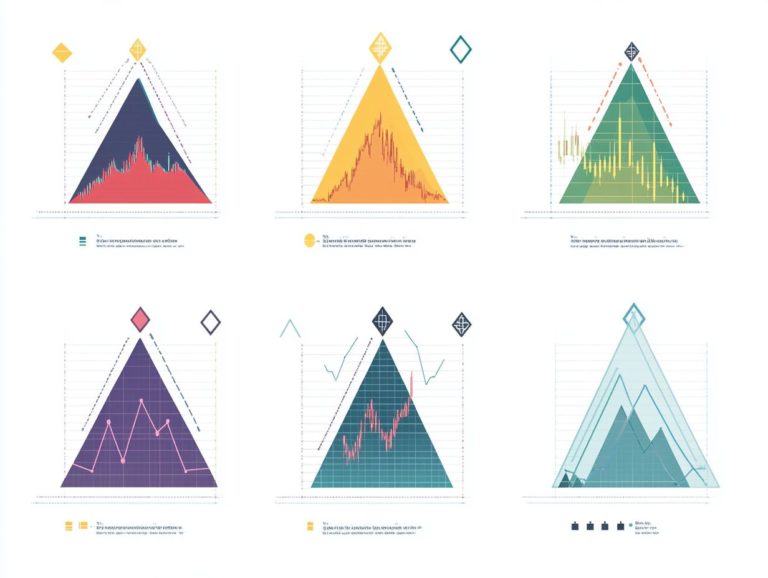8 Essential Technical Analysis Skills for Traders
In the fast-paced world of trading, mastering technical analysis is essential for making informed decisions.
This article delves into eight crucial skills that can elevate your trading game from understanding market trends and identifying support and resistance levels to using technical indicators and analyzing candlestick patterns.
You will also uncover the vital roles that risk management and chart patterns play in your overall strategy.
Whether you’re just starting out or have years of experience under your belt, these insights will help refine your approach and significantly boost your confidence in the market.
Contents
- Key Takeaways:
- 1. Understanding Market Trends
- 2. Identifying Support and Resistance Levels
- 3. Using Technical Indicators
- 4. Analyzing Candlestick Patterns
- 5. Applying Fibonacci Retracement
- 6. Utilizing Moving Averages
- 7. Knowledge of Chart Patterns
- 8. Risk Management
- How Can Technical Analysis Help Traders Make Informed Decisions?
- Frequently Asked Questions
- Ready to master the 8 essential skills for technical analysis?
- Why is trend analysis an important skill for traders?
- How can support and resistance levels help traders?
- What role do chart patterns play in technical analysis?
- How can candlestick patterns be useful for traders?
- Why are momentum indicators important for traders?
- What is the significance of moving averages in technical analysis?
- How can traders use Fibonacci retracements in their analysis?
Key Takeaways:

- Understanding market trends is crucial for traders to make informed decisions.
- Identifying support and resistance levels can help traders determine entry and exit points.
- Technical indicators, such as RSI and MACD, can provide valuable insights into market momentum and trend strength.
1. Understanding Market Trends
Understanding market trends is a crucial skill for you as a trader or investor, laying the groundwork for making informed investment decisions in the dynamic world of financial markets.
By considering factors like price action, risk management, and trading psychology especially in stocks like QQQ and NET you can refine your approach, as underscored by experts like Richard Moglen and resources from Investopedia and Udemy.
By recognizing these trends, you give yourself the power to adapt your strategies, ensuring you capitalize on potential opportunities while effectively mitigating risks.
Technical analysis is the study of past market data to predict future price movements, making it an essential tool in your arsenal.
This enables you to evaluate historical price movements and pinpoint key indicators that suggest future price behavior.
When you incorporate insights from behavioral economics, which explores how emotions and cognitive biases influence trading decisions, you gain a richer understanding of market dynamics.
Leveraging advanced trading platforms and resources, such as real-time data feeds and analytical tools, can significantly elevate your research process, equipping you with the insights necessary to navigate the complexities of the market with confidence.
2. Identifying Support and Resistance Levels
Identifying support and resistance levels is crucial for you as a trader, as these points serve as invaluable tools in forecasting price movement and establishing effective trading setups.
Mastering these concepts can significantly enhance your trading performance and decision-making in the stock market.
These levels are derived from a careful analysis of historical price data, where you observe the points at which prices have repeatedly reversed or stalled.
The importance of these levels cannot be overstated; they act as psychological barriers in the market, shaping trader behavior and sentiment.
By recognizing these key levels, you empower yourself to make more informed decisions regarding entry and exit points.
Understanding how to use these levels effectively helps you manage risk better, enabling you to set stop-loss orders just below support or above resistance.
This strategic approach not only safeguards your investments but also optimizes your overall trading metrics, ultimately leading to more consistent results over time.
3. Using Technical Indicators
Using technical indicators, such as moving averages, is essential in today s trading landscape, giving you the power to analyze financial markets and refine the accuracy of your investment decisions.
These tools offer valuable insights into market trends and price movements, providing quantifiable metrics that can help you forecast future price behavior.
Among the array of indicators, the Relative Strength Index (RSI) stands out by helping you identify overbought or oversold conditions, guiding you toward making timely entry or exit decisions.
Similarly, Bollinger Bands assist in measuring market volatility, enabling you to manage risk more strategically.
If you re a novice eager to enhance your understanding, you’ll find a wealth of online courses available on platforms like Coursera and Udemy.
These courses cover the fundamentals of these indicators and their practical applications, equipping you to develop robust trading strategies.
4. Analyzing Candlestick Patterns
Analyzing candlestick patterns is essential for your tools for analyzing market movements. These patterns help interpret price action with greater precision.
They offer insights into potential market reversals or continuations. These visual representations of price movements are crucial indicators of market sentiment and trading psychology.
By recognizing patterns like the hammer, doji, or engulfing candle, you can uncover valuable insights into possible trend shifts. Spotting a hammer at the bottom of a downtrend might suggest a bullish reversal. A doji at the peak could reveal indecision among traders.
Understanding these signals allows you to refine your trading strategies and enhance your risk management. With this knowledge, you can confidently set stop-loss orders and take profit levels based on the anticipated market behavior indicated by these formations.
5. Applying Fibonacci Retracement
Applying Fibonacci retracement levels can significantly enhance your ability to pinpoint potential price reversal zones. This refines your trading techniques and elevates your overall trading metrics.
This tool draws from the renowned Fibonacci sequence, where key levels are percentages of a notable price movement. Understanding levels like 23.6%, 38.2%, 50%, 61.8%, and 100% can be invaluable in positioning your trades.
By observing how an asset reacts at these points, you can identify areas of support and resistance. Support means the price tends to stop falling, while resistance indicates where it tends to stop rising.
For example, if a stock surged to $100 and then pulled back, Fibonacci retracement might show that the price finds support at the 61.8% level around $61.80. This suggests a great entry point for bullish trades.
6. Utilizing Moving Averages

Utilizing moving averages is crucial for traders. They help gauge market trends and enhance trading systems. These indicators smooth out price fluctuations, providing clarity in assessing trading performance over time.
Employing various moving averages like simple moving averages (SMA), exponential moving averages (EMA), and weighted moving averages (WMA) allows you to tailor strategies to current market conditions.
SMAs offer simplicity and reliability, while EMAs provide a quicker response to price changes. This makes them useful in more volatile markets.
Combining different moving averages reveals potential entry or exit points. You ll be ready to craft those winning trading plans! Numerous online trading courses offer insights into integrating these averages into effective trading systems.
This knowledge gives you the power to make well-informed investment decisions with greater confidence.
7. Knowledge of Chart Patterns
Knowledge of chart patterns is essential for traders. This skill set helps predict future price movements and apply technical analysis effectively within trading strategies.
When you understand these patterns, you can really tap into what the market is feeling! Familiarity with formations like head and shoulders, double tops and bottoms, and triangles provides valuable insights into potential bullish or bearish trends.
By identifying these patterns, you ll be ready to craft those winning entry and exit strategies! Integrating these insights with solid risk management principles will further strengthen your trading plan.
Continuously refine your skills through resources like online courses, webinars, and trading communities. This fosters a culture of ongoing education in this ever-evolving field.
8. Risk Management
Risk management is a cornerstone of your trading success. It allows you to assess how much risk you can handle and implement effective strategies that safeguard your capital while striving for optimal performance in the often unpredictable financial markets.
By incorporating various risk management techniques, such as stop-loss orders, you can limit potential losses on individual trades. This ensures that no single position has a detrimental effect on your overall portfolio.
Position sizing is equally crucial; it helps you determine how much capital to allocate to each trade in line with your risk profile.
Understanding the psychological aspects of risk management, particularly emotional control, is essential for maintaining discipline. When you manage your emotions effectively, you’re more likely to adhere to your strategies and steer clear of impulsive decisions. This ultimately cultivates a more consistent approach to engaging with the markets.
How Can Technical Analysis Help Traders Make Informed Decisions?
Technical analysis is your secret weapon as a trader! It offers valuable insights into market data and uncovers trading opportunities that enhance your investment decisions and trading metrics.
You can harness this analytical approach across various platforms, such as MetaTrader or TradingView, to visualize patterns and trends that shape your strategies. By utilizing indicators like moving averages or the RSI, you can gauge momentum and potential reversals, significantly refining your decision-making process.
The financial markets are always changing. Participating in online courses keeps you updated on new methodologies and tools. This helps you seamlessly integrate fresh knowledge into your practices to adeptly adapt to the ever-changing market landscape.
What Are the Different Types of Technical Analysis?
The various types of technical analysis, from chart-based techniques to quantitative methods, offer you a wealth of approaches to craft effective trading strategies. For those new to this field, exploring a beginner’s guide to technical analysis can significantly enhance your trading experience.
By leveraging tools such as moving averages, support and resistance levels, and oscillators which are tools that help measure the momentum of price movements you can uncover valuable insights into market trends and identify potential entry and exit points. On the flip side, fundamental analysis dives deeper into evaluating a security’s intrinsic value through economic indicators, earnings reports, and industry trends.
Imagine a trading system that seamlessly blends both analyses: it utilizes technical signals to time your trades while also scrutinizing a company s financial health through its earnings announcements. This approach not only helps you time your trades better but also ensures you’re informed about the company s financial health. Adopting such a holistic approach can lead to more robust trading strategies that cater to your unique style and risk appetite.
How Can Technical Analysis Be Used in Different Markets?
Technical analysis can be seamlessly applied across a variety of financial markets, including stocks, Forex, and commodities, giving you the power to refine your strategies for diverse trading platforms and market conditions.
The principles that form the backbone of technical analysis are remarkably consistent. They provide you with a solid approach regardless of the asset class. Successful traders recognize the importance of customizing their strategies to align with the unique characteristics of each market.
For instance, while Forex traders often seek specific indicators tied to currency volatility, those engaged in commodities tend to focus on supply-and-demand dynamics. You can enhance this adaptability by using trading platforms like MetaTrader and TradingView, which offer specialized tools and features tailored to meet the distinct needs of traders across various sectors.
What Are the Limitations of Technical Analysis?

While technical analysis provides valuable insights, recognizing its limitations is key to your trading success! Market dynamics, influenced by understanding how people behave in the market, can lead to trading mistakes and inaccuracies.
Relying solely on charts and indicators can create a false sense of security. This may cause you to overlook critical external factors like economic news or geopolitical events. Without a solid risk management strategy a plan to protect your investment from large losses you risk significant losses. Do not wait until it s too late!
Emotional discipline is vital for maintaining a balanced approach. It gives you the power to navigate the inevitable ups and downs of trading without giving in to panic or euphoria.
By integrating technical analysis with a broader strategy that includes mental fortitude and risk mitigation, you can significantly enhance your chances of achieving long-term success in the unpredictable world of trading.
How Can Traders Continuously Improve Their Technical Analysis Skills?
Continuously honing your technical analysis skills is essential if you want to elevate your trading knowledge and experience. Understanding the benefits of learning technical analysis allows you to adapt seamlessly to ever-changing market trends and refine your strategies with precision.
By taking advantage of online courses, you gain access to a treasure trove of information, including the latest methodologies and analytical techniques taught by seasoned industry experts. Reading trading books gives you valuable insights and real-world examples that uncover the core principles of successful trading.
Utilizing demo accounts creates a secure environment for you to practice and test your strategies without the worry of financial risk. This simulated trading experience not only aids in your skill development but also builds the confidence you need to make informed decisions when you finally step into the live market.
What Are the Common Mistakes to Avoid in Technical Analysis?
Common mistakes in technical analysis can significantly undermine your success as a trader. These often arise from emotional biases, a lack of discipline, and misinterpretation of technical indicators.
These pitfalls frequently lead to impulsive decision-making, where fear or greed dictate your actions instead of a well-structured plan. A key element in overcoming these challenges is developing a deep understanding of trading psychology. By cultivating self-awareness and emotional control, you can make rational, data-driven choices.
Establishing a disciplined approach such as consistently setting stop-loss levels and adhering to risk management strategies can help mitigate the effects of external pressures. By focusing on these crucial aspects, you can greatly enhance your technical analysis skills and foster a more resilient trading mindset.
Frequently Asked Questions
Ready to master the 8 essential skills for technical analysis?
The 8 essential technical analysis skills for traders are: trend analysis, support and resistance levels, chart patterns, candlestick patterns, momentum indicators, moving averages, relative strength index (RSI), and Fibonacci retracements.
Why is trend analysis an important skill for traders?
Trend analysis helps traders identify the direction of a market, which is crucial for making profitable trades. By understanding trends, traders can enter and exit positions at the right time.
How can support and resistance levels help traders?

Support and resistance levels are key areas of price where buying and selling pressure can be expected. Traders can use these levels to determine entry and exit points and manage risk.
What role do chart patterns play in technical analysis?
Chart patterns are formations on price charts that can signal potential trend reversals or continuations. By recognizing these patterns, traders can make informed decisions about their trades.
Start enhancing your technical analysis skills today and boost your trading success!
How can candlestick patterns be useful for traders?
Candlestick patterns reveal insights into market psychology. They help traders predict future price movements.
Combining them with other tools enhances their effectiveness.
Why are momentum indicators important for traders?
Momentum indicators, like the Relative Strength Index (RSI), show when a market is overbought or oversold. Traders use this information to make informed decisions and reduce risk.
RSI measures the speed and change of price movements.
What is the significance of moving averages in technical analysis?
Moving averages smooth price data and help identify trends. They also serve as support and resistance levels, confirming trends and guiding entry and exit points.
How can traders use Fibonacci retracements in their analysis?
Fibonacci retracements are powerful tools for spotting potential support and resistance levels. Traders use them to decide when to enter or exit the market and to set profit targets.






